Cornwall has always been a distinctive part of England. Eons ago two plates of the earth’s crust rammed into one another, uplifting and twisting the underlying rock into the wild and windswept headlands that created its magnificent scenery. Geographically, this southwestern-most tip of England dips it’s toes in the English Channel at a point where the Atlantic Gulf Stream comes closest to Britain, which blesses it with more temperate weather than the rest of the country.
Even the cultural identity of Cornwall is unique. Though everyone speaks English, locals have also carefully preserved their Cornish dialect, which is derived from their Celtic roots. Pasties, a kind of pastry pocket most often filled with beef steak, onion, potato and, turnips, originated in Cornwall, as did that mainstay of English tea and scones, Cornish clotted cream. Today Cornish cream has protected status; it can only be produced in Cornwall and is one of the county’s most important industries.
For a few decades, mining supplanted agriculture and fishing as the area’s most important industry, as rich deposits of tin, copper, and a pure white clay used in the manufacture of porcelain were discovered beneath its bucolic green hills. But by the late 20th century, mining was no longer economically feasible and, with the exception of a few clay pits, the mines ceased operation. Instead, Cornwall turned it’s view toward tourism, capitalizing on its natural beauty and the moderating influence of the Gulf Stream, which provides Cornwall with the mildest and sunniest weather in the UK. This unique climate proved ideal for gardens that today feature scores of plant varieties that cannot exist in other parts of England, making them some of the most beautiful places to visit in Cornwall.
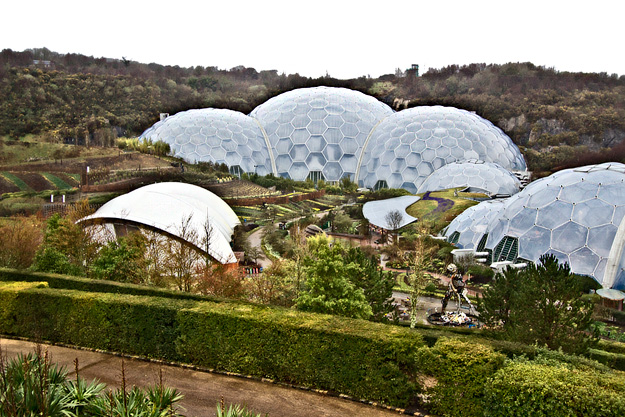
One of these gardens, The Eden Project, was built in a 160-year-old china clay quarry that had been closed down in 1995. A year after the pit’s closure, Tim Smits, who conceived the idea for the Eden Project, drew initial sketches for the garden’s design on a cocktail napkin in a pub. Smits wanted a place to showcase the world’s most important plants and he realized he would need a very, very big site. The abandoned clay pit seemed perfect and gradually, the design evolved into a series of giant bubbles because dome-like structures can settle on any surface, even an irregular clay pit.
Smits approached the Millennium Commission, an agency in the United Kingdom that provided funding for projects to commemorate the turn of the century. His idea was approved and Smits began building in 1998, while simultaneously raising 50% of the matching funds required in order to receive his Millennium grant. His vision included two enormous Biomes – giant bubble domes – that would house a Rainforest garden and a Mediterranean garden. On the day I visited, from a distance the Biomes looked like small upside-down bowls covered in bubble wrap. Closer, however, their enormity became apparent. Each is large enough to hold the Tower of London and the Guinness Book of Records declares them to be the biggest conservatories in the world.
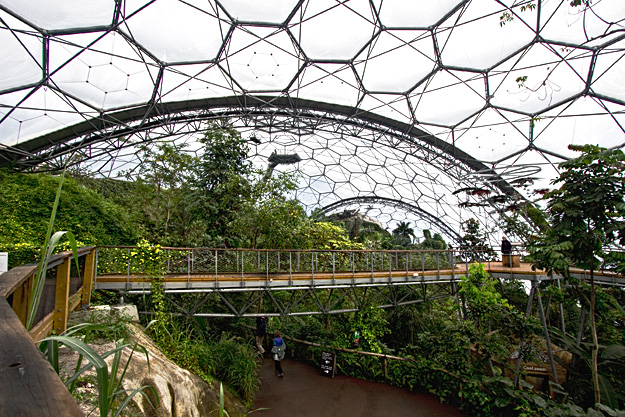
The Biomes are home to more than a million plants that represent nearly 4,000 species, many of which were grown from seed in the Eden Project’s nursery. I strolled through the Rainforest Biome on the Canopy Walkway, which gave me a birds-eye view from treetop level while learning why rainforests are so special from educational displays stationed along the path. If I had any remaining doubts about the magnitude of the Biome, I needed only to look up to “The Nest,” a small platform at the top of the dome, which from my perspective on the walkway was little more than a speck. When my clothing began to cling to me in the steamy environment, I made my way to the Mediterranean Biome to stroll through beds of kaleidoscopic tulips. Today the Eden Project is more than just one of the most beautiful gardens in the world. The venue has hosted arts and music events, works in tandem with schools to create learning experiences for students, and sponsors programs to educate businesses and individuals about environmental issues and sustainable living.
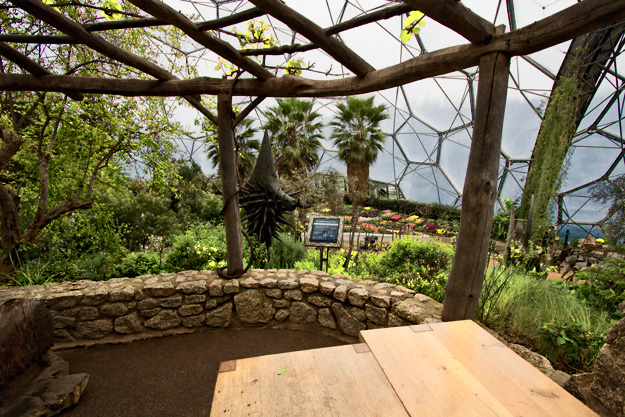
The Eden Project was not the first Cornwall undertaking for developer Tim Smits. In 1990 he discovered the derelict gardens at the Heligan estate, which had been the seat of the Tremayne family for more than 400 years. At the end of the 19th century, the 1,000+ acre estate included a Japanese garden, a Sundial garden described as “the finest herbaceous boarder in England,” and an Italian garden, however the onset of World War One sounded its death knell. Shortly after England declared war on Germany, all the young Cornish men were loaded aboard ships and sent to the front lines. Lacking men to perform heavy labor, the estate fell into disrepair and when the Tremayne family could no longer maintain Heligan House, it was converted to a Convalescence Hospital for Officers. After the war it was rented out to various tenants, including the U.S. military, which used it as a base for troops during WWII. Eventually it was converted to apartments and sold off in 1973-74, where it languished until Smits and a descendant of the Tremayne family decided to rescue it.
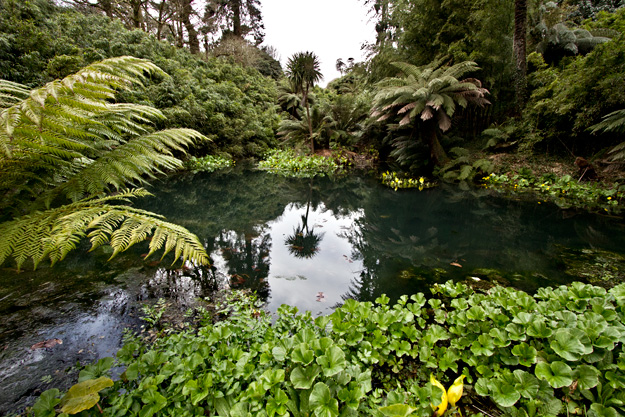
Smits immediately began clearing the property, beginning with the Melon Yard and the Italian Garden, and within two years he had signed a lease with the Tremayne family and opened “The Lost Gardens of Heligan” to the public. For the better part of a day I explored the estate’s pastures, woodlands, and wetlands, including the ‘Jungle,’ where a boardwalk runs through a ravine planted in semi-tropical trees and plants, and the Wider Estate, where black and white banded Saddleback Pigs repeatedly rammed their fleshy snouts into the moist mud in search of grubs and tender roots. The traditional vegetable garden and greenhouse that provided produce and flowers for Tremayne tables were interesting, and I thoroughly enjoyed strolling romantic paths through green-black Magnolia trees laden with rich pink blooms, but none of these ranked among my favorite attractions at The Lost Gardens of Heligan.
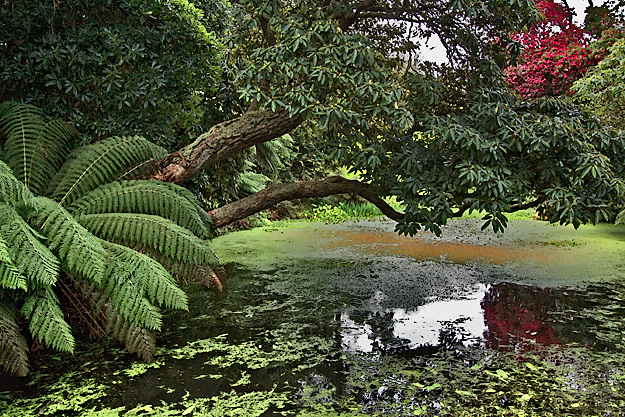
High on my list was the series of living sculptures stationed along the Woodland Walk, which are among the most popular attractions at the garden. They happened quite by accident. The great storm of 1990 had exposed an enormous tree root that was too big to bury and too hard to burn. Instead, Cornish artists Pete and Sue Hill were commissioned to create a sculpture that would disguise the root. The result was “The Giant’s Head,” a behemoth creature that appears to be buried up to his nose. The tree root forms the framework for the skull and the giant’s face is crafted of mud pinned with Sycamore twigs. His skin is planted with Mind Your Own Business and his spiky green hair is Montbretia, which turns orange in summer and dies back to grey in the winter. His eyes are mosaics made from bits of china and glass found on site in the estate’s old Bottle Dump.

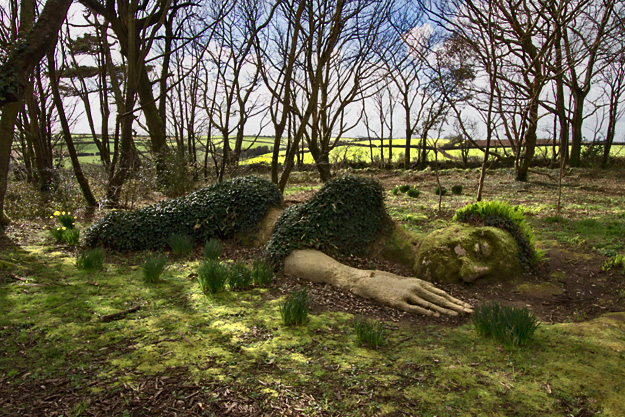
The Giant’s Head was a hit with visitors and soon the Hills were hard at work on a second installation, “The Mud Maid.” She slumbers at the edge of woodlands, with sunlight from the gently rolling hills of Kestle Farm filtering though the trees to warm her berth. The Mud Maid has a hollow framework of timber and windbreak netting, to which sticky mud was applied. Her hands and face are a mixture of mud, cement, and sand, originally coated with yogurt to stimulate the growth of lichens; her head is planted with Woodsedge and Montbretia; and ivy provides her garments.
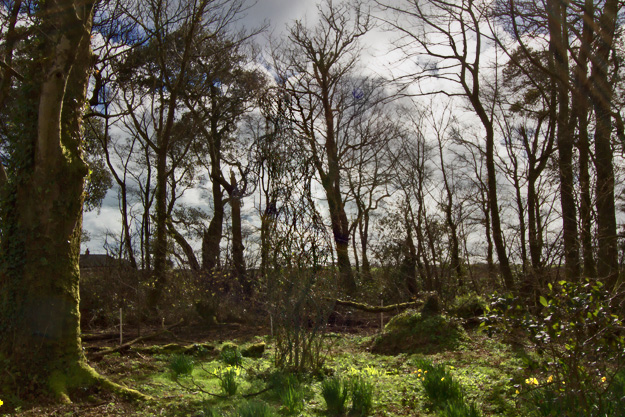
A third sculpture is less obvious and much harder to spot, though no less intriguing. “The Grey Lady,” a transparent and hollow form constructed of galvanized steel, stands in a copse of trees at the intersection of several paths. It took me a minute to pick her out among the naked trees that wreathed her like a witches coven, but once she came into focus a chill ran down my spine. I later learned that The Grey Lady was named after a mysterious grey figure who is said to disappear after emerging from the estate house.

My other favorite was the pasture, where a team of heavy horses pulled a traditional hand-guided plow across a humpbacked green hill, as it would have been done before farming became mechanized. The field will be planted with poppy seeds to commemorate the 100th anniversary of Britain’s declaration of war against Germany in 1914. Poppies are symbolic of WWI for the British, who lost so many fine soldiers in the area known as Flanders in France and Belgium, where their blood was said to mingle with the poppies that blanketed the fields. On Sunday, August 3, 2014, when the field at Heligan is awash in crimson poppies, the gardens will commemorate the centenary of the outbreak of WWI with a special event.
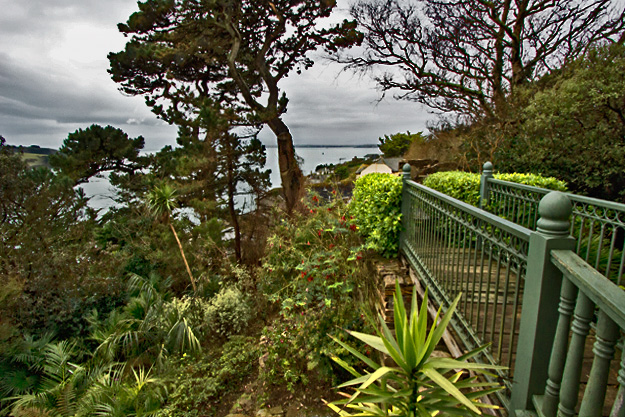
Eden Project and the Lost Gardens of Heligan may be the two largest gardens in Cornwall, but they are only the tip of the iceberg, so to speak. According to Visit Cornwall, the county is home to more than 40 gardens that contain a wealth of “rare and beautiful plants and trees,” and I was determined to see as many as my short six day stay allowed. Fortunately, Lamorran House Gardens was next door to Stargazers, my lovely St. Mawes Retreats holiday rental house. Though the gardens were not yet open for the season, my host Amanda Selby of St. Mawes Retreats arranged for me see them one afternoon. We spent an idyllic couple of hours meandering serpentine pathways through four acres of woodlands, Japanese water gardens, and Venetian influenced fountains and statues, which cascade down a hillside and offer stunning views toward St. Anthony Head and the sea.
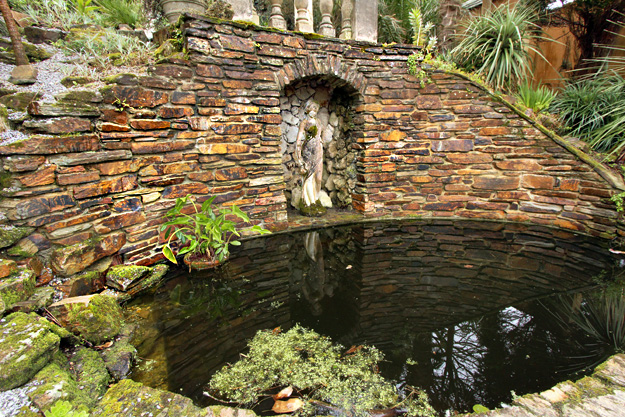
When grey skies threatened to spill over, we scurried back up the hill and knocked on the door to offer our thanks to the kind owner who, to our surprise, invited us in for coffee. Over the past 32 years, Robert and Maria Dudley-Cooke have transformed the property into a Mediterranean-style garden modeled after the great gardens of the Italian Riviera. On occasion the work has presented tremendous challenges, as this example in their brochure, which relates the story of the installation of their cupola:
“So dense was the undergrowth in this part of the garden at the time of clearance that it was not possible to discern that the land fell away sharply on a bank at this part. Some 10 feet in fact. During clearance the owner with electric hedge cutters working suddenly fell from his ladder whist leaning over too far. He became held steadfast in the thicket below, with a finger lodged in the trigger of the hedge cutter, the blades therefore continuing to operate very close to his face. A gentle request to his wife kindly to switch off the electricity, which was hurriedly assented to, saved the day and prevented the site being constructed becoming a mausoleum rather than a cupola.”
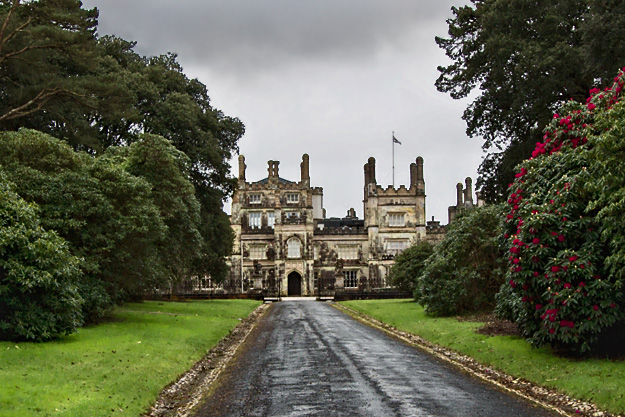
One final day, Amanda and I braved grey and drizzly weather to visit Tregothnan Historic Gardens, a living country estate that has been pioneering botanical firsts since 1334. Our personal guide, Alison, who was sensibly decked out in woolen cap and heavy jacket, led us past the imposing mansion, which is still occupied by descendants of the heiress Johan de Tregothnan. Beyond the estate’s famous Rhododendron tunnel she pointed out blooming Camellias and Magnolias, a burnt caramel tree that takes its name from the fragrance it emits during the summer, and a ‘Dinosaur tree’ thought to be extinct until 1994 when a handful of trees were discovered in a remote Australian valley.
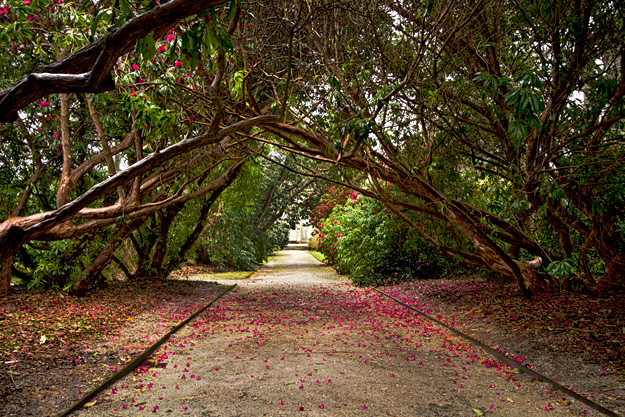
Though the botanicals at Tregothnan were lovely, I was more impressed by the working nature of the estate. As they have been doing for generations, tenant farmers still work the land and produce an array of local products that include English charcoal, Manuka honey, flowers, Kea Plums, and tea. Our tour ended at the tea plantation, where Alison pinched off a tiny leaf at the very tip of a branch, explaining that Tregothnan tea is made only from this smallest, most tender part of the tea leaf.
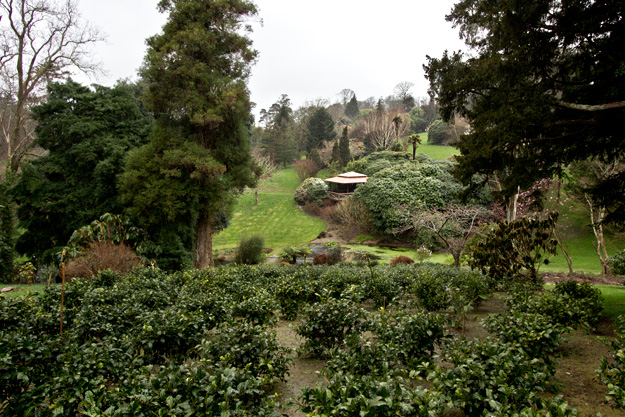
With only a knit cap and hoodie to protect me from the rain I was shivering and soaked, so I politely asked that we head back to the offices. Once there I warmed up while sipping Tregothnan’s Earl Grey tea, which is infused with pure Bergamot oil, giving it a delightfully bright and slightly floral flavor. It was an appropriate and delicious ending to my week in Cornwall, my only regret being I did not have time to visit more of the 40+ private and public gardens scattered around Cornwall.

Visiting the Gardens of Cornwall:
Eden Project, located in St. Austell, is open every day of the year, with the exception of December 24 and 25. During low season it is open from 10 a.m. to 6 p.m.; high season from 10 a.m. to 8 p.m. Tickets are priced at approximately $40 for adults, $31 for students and seniors over 60, and $23 for children aged 5-16 (children aged 0-4 free). On the days when the site is open until 8 p.m., discounts are available for anyone entering after 3:30 p.m.
The Lost Gardens of Heligan, located in St. Austell, is open every day of the year, with the exception of December 24 and 25. During low season it is open from 10 a.m. to 5 p.m.; high season from 10 a.m. to 6 p.m. Tickets are priced at approximately $20 for adults, $17 for seniors, $10 for children aged 5-16 (children aged 0-4 free), and $51 for families (2 adults & up to 3 children).
Lamorran House Gardens, located in St. Mawes, is open Wednesdays and Fridays, April through September, from 10 a.m. to 5 p.m. Admission for adults is $14; no charge for children under 16.
Tregothnan, located in Truro, is a private estate, however they offer a limited number of Private Garden Visits and monthly tours. The estate is also open to the public once each year during their Annual Charity Garden Weekend, the largest of its kind in the UK.
Disclosure: My visit to Cornwall was hosted by St. Mawes Retreats, however, the receipt and acceptance of complimentary items or services will never influence the content, topics, or posts in this blog. I write the truth, the whole truth, and nothing but the truth.

Those sculptures are really amazing, Everything looks perfect in that place. Definitely I will visit the garden if I have the chance too.
Hi Tina: The gardens all over Cornwall are just beautiful, and each one is vastly different from the others.
Beautiful photos. Can I add one piece of advice? Read the local paper and look for open garden announcements. Or if you see a sign pointing to one, follow it. Open gardens are held to raise money for one cause or another, and they give you entry to private gardens–sometimes just one, sometimes several. Some will be grand and some will be more ordinary, but all will be fascinating.
Hi Ellen. What a fantastic tip. Thanks so much for taking the time to share it.
Cornwall has been on my gardens to do list for a long time. I enjoyed this virtual visit. I write about gardens a lot. Here are a few I recommend getting to at some point, http://weekendadventuresupdate.blogspot.com/2014/03/greater-east-bay-walnut-creek-ruth.html
http://travelswithcarole.blogspot.com/2012/09/things-to-do-grotto-portland-oregon.html
Hi Carole: Glad you enjoyed my article and thanks for sharing a couple of your favorite gardens.
As someone who just visited (and LOVED) the Butchart Gardens in Victoria, Canada, the Eden Project (which I heard of in the book The Optimist) is a destination that will definitely make my list of places to see when I hit the UK. Thanks for this post, which cemented my decision!
You’re welcome, Ian. I’ve also been to Butchart Gardens and they are also spectacular, but very, very different from Eden Project.
Dear Barbara I visited the Lost Garden some six times during its progress into something so lovely that I swore that one day I would design my own. After nearly five years of hard slog that dream has arrived. My six acre garden is my pride and joy with waterfalls and lake and herbaceous Victorian borders along the arched tunnel of climbing roses and clematis leads into my italian garden. It is almost completed though we lack a few statues but we have that on order for next Spring. What dreams can do simply amazes me sometimes and the effort at my age was worth every little pain. Retirement gave me a job to complete and I did not fail. Thanks to those garden visits that gave me ideas beyond my station I did it all myself and saved a lot of worry and money too.
Hello Sir Kevin (if I may call you that): Your garden sounds remarkable. Do you plan to open it to the public? I’m totally with you about dreams – we should never give up on them. Kudos to you for following yours.
I love the look of the lost gardens with its superb themed sculptures. The half buried giants head is really striking.
I think the Giant’s Head was my favorite of the earth sculptures as well, Mark.
Those gardens look incredible for a short, romantic walk. I love them!
Hi Suki. Of the four gardens I visited in Cornwall I would say that the Lamorran House Gardens were the most romantic, but all were wonderful.
Good work, it’s pleasure to read your interesting articles. Waiting for more
Thank you Povonte. Glad you enjoyed my article.
A cornish pasty! One of my favourite foods, of which i can not get any around here! 🙁 Love the grass sculptures though
Me too Mic – I can’t fathom why England has a reputation for having poor food.
Hi!
If you travel a lot you should try to take part in this contest http://en.millionyou.com/lot
Shoot a short video from a place you travel to and win free flight tickets 🙂
Beautiful. I visited some of these gardens 20 years ago. It’s time for another visit. Incredible pictures.
Thanks so much Christopher! Glad you enjoyed my story.
Wow…gorgeous! I love those woody sculptures. For me, it conjures up ideas of creatures that come alive in storybooks. Someday!
Hi Corinne – interestingly, the sculptors have written two children’s books around the Giant’s Head and Mud Maid, which are sold at Heligan 🙂
Cornwall and Devon are certainly worth visiting! Would just like to correct you on your earlier comment – Clotted cream can be produced anywhere – it is the Cornish Pasty that can only be produced in Cornwall – if it is from anywhere else, it is just a Pasty, not a Cornish Pasty.
Hi Kalilileth: You are correct – clotted cream can be produced anywhere. It is Cornish clotted cream that can only be produced in Cornwall. In 1998, the European Union gave the term Cornish clotted ream protected status as a Protected Designation of Origin (PDO), as long as the milk is produced in Cornwall and the minimum fat content is 55%. I appreciate the heads up and have modified my article to add the word “Cornish.”
Cornwall is a very beautiful part of England with its own unique character. You have done it proud! Thank-you.
Thank you Linda. What a wonderful comment to receive from a reader!